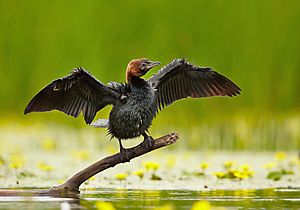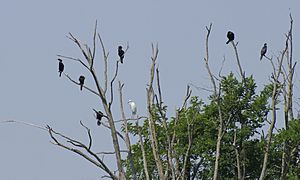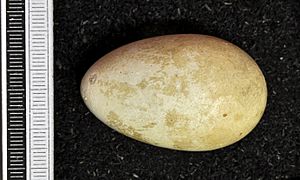Pygmy cormorant facts for kids
Quick facts for kids Pygmy cormorant |
|
|---|---|
 |
|
| Conservation status | |
| Scientific classification | |
 |
|
| Range of M. pygmaeus Breeding Resident Non-breeding Vagrant (seasonality uncertain) | |
| Synonyms | |
|
Phalacrocorax pygmeus |
The pygmy cormorant (Microcarbo pygmaeus) is a small bird that belongs to the cormorant family. These birds are known for diving into water to catch fish. Pygmy cormorants live and have their babies in places like south-eastern Europe and south-western Asia.
Some pygmy cormorants move to warmer areas for winter. This is called migration. Birds from the north usually fly further south. Sometimes, they are seen in western Europe, but this is rare.
Contents
Where They Live
Pygmy cormorants live in a large area. This area stretches from south-east Europe to south-west Asia. You can find them as far east as Kazakhstan and Uzbekistan.
They are most common in south-east Europe. This includes countries like Albania, Greece, Bulgaria, and Romania. They also live in Turkey, Iran, Iraq, and Israel.
In the past, many pygmy cormorants lived in Romania. Large groups were found in the Danube Delta. However, their numbers dropped a lot in the 1960s. This happened because their homes were destroyed. Many wet areas were drained for farming.
Today, the biggest group of pygmy cormorants lives in the Danube Delta. There are about 4,000 pairs of these birds there. Experts believe that most pygmy cormorants, about 74-94%, live in Europe.
Home and Habits

Pygmy cormorants like to live near water. They prefer pools with lots of plants. Lakes and river deltas are also favorite spots. They do not like cold or dry mountain areas.
These birds often live in rice fields. They also like other flooded places with trees and bushes. In winter, they might move to waters that are a bit salty. This includes river mouths or coastal lakes.
Pygmy cormorants can live alone or in groups. They have learned to live near people. They build their nests from sticks and reeds. They often build them in thick plants, trees, or bushes. Sometimes, they build nests in reeds on small floating islands.
Life Cycle
Around late May or early June, the parents start to incubate their eggs. Both the mother and father bird take turns sitting on the eggs. This lasts for about 27 to 30 days.
After hatching, the baby birds stay in the nest. They are fed by their parents. The parents bring them small fish and other water animals. The young birds become independent after about 70 days.
Pygmy cormorants often share their homes with other water birds. These include egrets, herons, and spoonbills.
See also
 In Spanish: Cormorán pigmeo para niños
In Spanish: Cormorán pigmeo para niños



